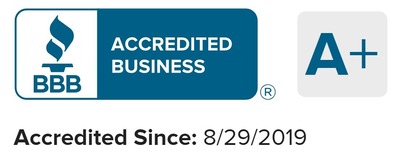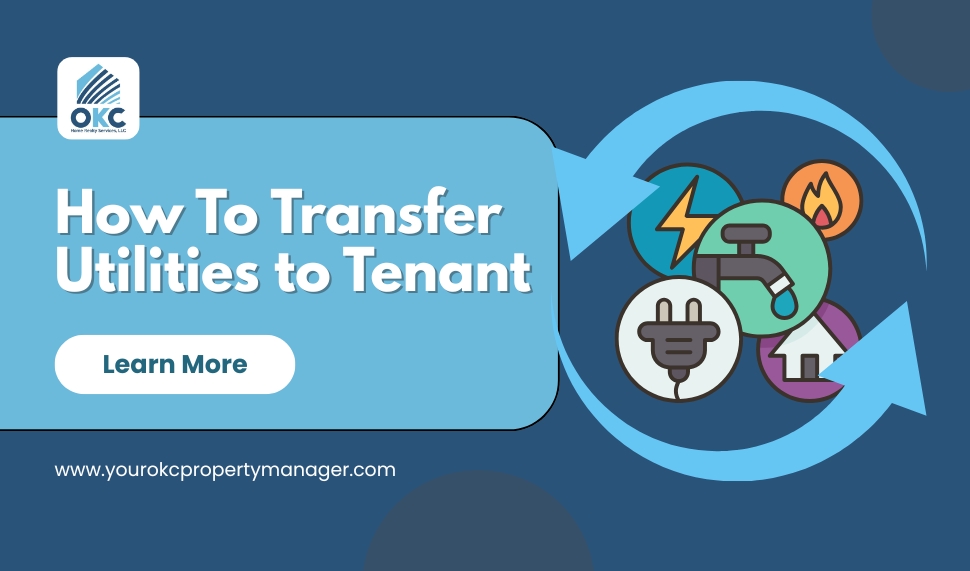Ever felt that jolt when you open a bill you shouldn’t have to pay? Imagine it’s a $300 electric bill, only to realize it’s for your rental property that a tenant just moved into. Unfortunately, this happens to landlords all the time when utility transfers aren’t handled correctly.
Transferring utilities to a tenant may sound like a small detail, but in property management, it’s one of the biggest safeguards against unexpected costs and disputes. Over the past 15 years of managing rental properties across Oklahoma Cities, I’ve seen how overlooked utility transfers can lead to unpaid bills, legal confusion, and even service shutoffs that disrupt tenants and damage landlord–tenant relationships.
That’s why this article focuses on how to transfer utilities to a tenant. I’ll walk you through a clear step-by-step process, explain who is responsible under Oklahoma law, and highlight common mistakes landlords should avoid. By the end, you’ll have a proven system to manage electricity, water, gas, trash, and internet transfers with confidence without leaving yourself financially exposed.
How To Transfer Utilities to Tenant: Step-by-Step Guide
Transferring utilities to a tenant doesn’t have to be complicated, but doing it the right way is crucial to avoid disputes, unexpected bills, and tenant confusion. The process starts before move-in day and continues through the tenant’s occupancy until move-out. Here I’ll break the process into clear, actionable stages that Oklahoma landlords can follow with confidence.
Step 1: Confirm Responsibility in the Lease (Before the Tenant Moves In)
The entire process begins with your lease agreement. In Oklahoma, leases are very crucial, and courts enforce them strictly. If your lease doesn’t clearly assign who pays for utilities, you’ve basically opened the door to arguments later. That’s why the very first thing you should do before the tenant even moves in is spell out utility responsibility in writing.
For example, you can use wording like this:
“Tenant shall be responsible for establishing and paying for all utility services (electricity, gas, water, sewer, trash, internet/cable) unless otherwise agreed in writing. Tenant must transfer utilities into their name no later than the first day of occupancy and provide proof of activation to Landlord.”
This type of clause eliminates ambiguity and ensures both landlord and tenant clearly understand their utility responsibilities.
Step 2: Provide Clear Instructions to the Tenant
Never assume tenants know what to do. Many renters, especially younger tenants or people moving from out of state, have never dealt with setting up utilities before. A simple one-page instruction sheet can save you hours of back-and-forth later. I recommend sending it by email right after the lease is signed, and also attaching it to the lease packet.
Here’s what to include:
- List of utilities they must set up (electric, gas, water, trash, internet/cable).
- Contact info and websites for providers in that property’s area (e.g., OG&E or PSO for electricity in OKC/Tulsa; Oklahoma Natural Gas for gas; city utilities for water/trash).
- Exact deadline—tell them utilities must be active in their name by move-in day at the latest.
- Proof requirement—ask them to send you a confirmation email, account number, or screenshot once the account is activated.
Step 3: Document the Utility Transfer with Meter Readings
Here’s where a lot of landlords slip up. Even with a good lease and clear instructions, disputes can still arise over which utility usage belongs to the landlord and which belongs to the tenant.
Imagine this: You leave OG&E in your name until the tenant moves in. A week later, the tenant claims their first $200 electric bill isn’t their sit was from before they activated the account. Without evidence, you could be stuck footing that bill.
The solution? Meter photos.
On move-in day, you should take clear, time-stamped photos of every utility meter (electric, gas, water). Then:
- Save them in a tenant file.
- Email copies to the tenant (this transparency builds trust).
Now, if a billing dispute ever pops up, you’ve got proof. The utility company can prorate usage exactly, and the tenant can’t claim you dumped old charges on them.
Step 4: Coordinate the Actual Transfer with Utility Companies
Once the lease is signed and instructions are sent, it’s time for the actual switch. In Oklahoma, the process is usually straightforward, but each utility has its specific rules.
- Electricity – OG&E or PSO handles most areas. Transfers can often be done online or by phone.
- Gas – Oklahoma Natural Gas usually requires a valid ID and may charge a deposit. Transfers take a few business days, so tenants should not wait until the last minute.
- Water & Trash – Most are city-run. In Oklahoma City, Edmond, or Norman, tenants usually must create accounts through the city’s online portal. Some still require in-person setup with a driver’s license and a lease agreement.
- Internet/Cable – Providers like AT&T or Cox handle this. Not legally required, but tenants will ask, so include it in your info sheet.
Step 5: Verify and Follow Up
Too many owners assume tenants follow through, then get a surprise bill weeks later.
Instead, always verify. Ask tenants to send you:
- A screenshot of their online utility dashboard, or
- An activation email/account confirmation.
If you want to take it a step further, set a firm deadline in your lease: utilities must be in the tenant’s name within some days of move-in.
And if they don’t comply? Send a written notice with a deadline. Most tenants will get it done immediately once they realize you’re serious. If not, your lease clause should give you the right to:
- Put utilities back in your name,
- Pay the bill, and
- Charge the tenant for costs
That may sound harsh, but it prevents you from being stuck with hundreds of dollars in unpaid bills.
Step 6: Finalize at Move-Out
When the tenancy ends, the utility transfer process runs in reverse. Don’t skip this stage, it’s just as important as move-in.
Here’s the checklist:
- Take final meter photos with timestamps.
- Contact providers to request a final bill in your name, ending on the tenant’s official move-out date.
- Provide prorated amounts if the tenant moved mid-billing cycle.
- Keep copies of all final bills with your tenant’s file in case of disputes during the security deposit return process.
This protects you in two ways: it makes sure the tenant isn’t unfairly billed for time after they’ve left, and it ensures you’re not liable for services after their departure.
Who Is Responsible for Utilities in Oklahoma?
This is one of the most common landlord questions, and the answer depends on the lease.
- By default, Oklahoma law doesn’t force tenants to pay utilities unless the lease says so. The landlord must ensure the property is habitable, which means utilities must be available, but that doesn’t mean the landlord must pay them.
- If the lease is silent, Courts may interpret that the landlord is responsible for essential utilities (water, electricity, gas). That’s why silence is dangerous.
Always assign responsibility clearly in the lease. However, if you agree to supply utilities to the tenant but don’t, then the tenant can deduct the cost of rent, arrange the utilities by themselves, as well as end the rental agreement with a written notice as per Oklahoma Law.
Common Mistakes Oklahoma Landlords Make (and How to Avoid Them)
Even experienced landlords can make mistakes when it comes to utility transfers. Here are the most frequent pitfalls and how to avoid them so you can keep your properties running smoothly and your tenants happy.
1. Unclear Lease Terms
Mistake: Many landlords leave utility responsibilities vague in their leases. Without clear language, tenants may assume certain utilities are included in rent, or disputes can arise about who pays for what. This often results in unpaid bills landing back on the landlord’s doorstep.
How to Avoid:
Always include a detailed utilities clause in your lease. Spell out:
- Which utilities the tenant is responsible for (electricity, gas, water, trash, internet/cable).
- Exact deadlines for transferring accounts into the tenant’s name.
- Consequences for missed transfers or unpaid bills, such as treating unpaid utilities as additional rent.
Additionally, having your lease reviewed by a local property attorney familiar with Oklahoma landlord-tenant law can ensure your clause is enforceable.
2. Skipping Verification
Mistake: Some landlords assume tenants have set up utilities correctly. Weeks later, a bill arrives in the landlord’s name, and suddenly you’re stuck paying for services the tenant should have taken over.
How to Avoid:
Always verify the transfer before move-in:
- Require tenants to send proof (account numbers, confirmation emails, or screenshots).
- Follow up with utility providers if needed.
- Include a plan for vacancies: if the property is empty for a few days or weeks, make sure the account can revert back to the landlord temporarily to prevent service interruptions or security risks.
Make verification part of your move-in checklist. Consider withholding keys until proof of utility transfer is received. This may feel strict, but it ensures no surprises later.
3. Ignoring Local Laws
Mistake: Utility transfer rules aren’t the same everywhere. Landlords sometimes overlook city or municipal regulations, which can create legal headaches.
How to Avoid:
- Research local ordinances and utility provider policies before drafting your lease.
- Work with a property manager or attorney to ensure your process is compliant.
- Factor in municipal rules for deposits, service transfers, or shared meters.
Each Oklahoma city may have different rules regarding billing and service activation timelines. Knowing these in advance prevents disputes and potential fines.
4. Poor Communication
Mistake: Landlords often assume tenants know how to transfer utilities or when they should do it. The result? Delays, service interruptions, or frustrated tenants calling you repeatedly.
How to Avoid:
Provide a list with:
- Utility provider contact information and websites
- Estimated costs for each utility
- A clear timeline for transfers (e.g., within 3 days of lease start)
- Follow up after move-in to ensure everything is active.
Early communication reduces headaches, prevents last-minute scrambles, and demonstrates professionalism. Example: Please contact OG&E and Oklahoma Natural Gas to transfer accounts into your tenant’s name no later than their move-in date. Ask confirmation email or a screenshot of the account setup by their first day of occupancy.
By addressing these common mistakes, Oklahoma landlords can avoid unnecessary bills, disputes, and stress, while keeping tenants happy and properties well-managed.
Final Thoughts on transferring utilities to tenants
Getting utilities transferred doesn’t have to be stressful. As long as your lease is clear, you give tenants the right instructions, and you double-check everything with meter readings and confirmations, you’ll avoid most of the common headaches Oklahoma landlords face. A little preparation up front saves you from surprise bills and disputes later.
If you’d rather not deal with these details yourself, that’s where we come in. OKC Home Realty Services helps landlords all across Oklahoma City manage rentals the right way. From setting up leases to finding tenants and keeping your property in great shape, we take care of it all.
FAQs on transferring utilities to the tenant
What documents do you need for utility transfer?
Most utility companies across Oklahoma require a government-issued photo ID, proof of your new address (such as your lease agreement), and sometimes your Social Security number for verification. Some providers may also require a deposit if you’re a new customer or have limited credit history.
How much does it cost to get utilities transferred?
Transfer or setup fees vary depending on the provider. On average, you can expect $20–$50 for electricity, water, or gas service transfers. Some companies may also require a refundable deposit (usually $100–$200), which will be credited back when your account closes in good standing.
How do I split utilities between tenants?
If multiple tenants live in the home, utilities can be split in one of two ways:
Single account holder: One tenant sets up all utilities in their name, and housemates reimburse their share each month.
Split accounts: Some utilities (like internet or electricity) can be placed in different tenants’ names to spread responsibility.
It’s best to clearly agree on a system before moving in to avoid confusion.
Can you change a name on a utility bill?
Yes, but the process depends on the provider. Typically, you’ll need to contact the utility company directly and provide proof of residency (lease agreement) and identification. In many cases, they require closing the old account and opening a new one under the new name. This ensures the correct person is legally responsible for the service.

Author
Scott Nachatilo is an investor, property manager and owner of OKC Home Realty Services – one of the best property management companies in Oklahoma City. His mission is to help landlords and real estate investors to manage their property in Oklahoma.
 (
(









